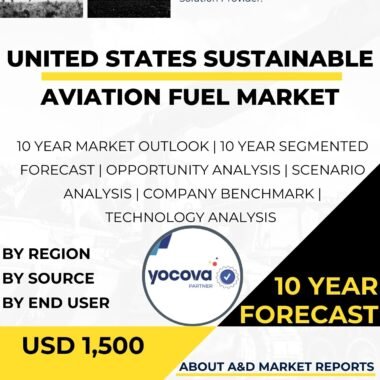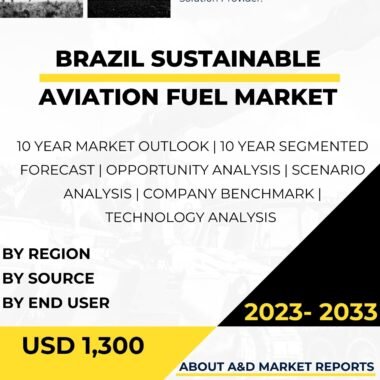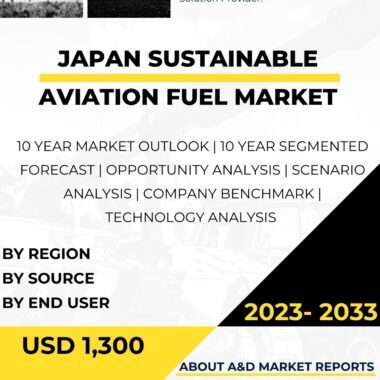Description
The Singapore Sustainable Aviation Fuel Market:
The sustainable aviation fuel (SAF) market in Singapore has been gaining momentum in recent years, driven by the aviation industry’s growing commitment to environmental sustainability and reducing carbon emissions. Sustainable aviation fuel, also known as biofuel or alternative aviation fuel, is a renewable and low-carbon substitute for traditional fossil-based jet fuel. This article provides an overview of the Singapore sustainable aviation fuel market, including key drivers, major players, adoption challenges, policy initiatives, and future prospects.
Singapore’s aviation sector is a vital component of the country’s economy, with Changi Airport being a major international hub connecting travelers and cargo across the globe. As the aviation industry faces increasing pressure to address its environmental impact, sustainable aviation fuel has emerged as a promising solution to reduce greenhouse gas emissions and mitigate the sector’s contribution to climate change.
One of the primary drivers for the growth of the sustainable aviation fuel market in Singapore is the global aviation industry’s commitment to achieving carbon-neutral growth. In response to the International Civil Aviation Organization’s (ICAO) Carbon Offsetting and Reduction Scheme for International Aviation (CORSIA), airlines are seeking ways to reduce their carbon footprint and offset their emissions. Sustainable aviation fuel offers a viable pathway to meet CORSIA requirements and reduce the industry’s overall carbon footprint.
Moreover, Singapore’s strategic location and well-developed aviation infrastructure make it an ideal location for sustainable aviation fuel adoption and production. With its major international airport, Changi, and active aviation industry, Singapore has the potential to become a regional hub for sustainable aviation fuel supply and distribution.
The Singapore government has also shown its commitment to sustainability and reducing carbon emissions in the aviation sector. Various policy initiatives and incentives have been introduced to support the growth of sustainable aviation fuel. For instance, the Civil Aviation Authority of Singapore (CAAS) has implemented the Sustainable Aviation Fuel Initiative (SAFI) to promote the use of sustainable aviation fuel and encourage airlines to include it in their fuel blends.
Furthermore, the Singapore Green Plan 2030, unveiled by the government, includes targets to reduce emissions in the transport sector, which encompasses aviation. This plan aims to promote sustainability and environmental conservation across all industries, including aviation.
The adoption of sustainable aviation fuel in Singapore is not without its challenges. One of the primary obstacles is the higher cost of sustainable aviation fuel compared to conventional jet fuel. The production and distribution of SAF are currently more expensive due to limited scale and technology maturity. Airlines may be hesitant to invest in SAF adoption if the cost difference remains significant.
Another challenge lies in the availability and scalability of sustainable aviation fuel production. To meet the growing demand for SAF, it is essential to establish a robust supply chain that can sustainably produce and deliver sufficient quantities of the fuel. Investment in research and development, along with innovative technologies, is crucial to enhancing production efficiency and driving down costs.
Certification and standardization of sustainable aviation fuel also play a crucial role in its adoption. Ensuring that SAF meets the necessary quality and safety standards is essential for widespread acceptance by airlines and regulatory bodies. Standardization efforts, such as those undertaken by ASTM International and other organizations, are critical for building trust in sustainable aviation fuel and streamlining its integration into existing aviation infrastructure.
Despite these challenges, the future prospects for the Singapore sustainable aviation fuel market remain promising. As the global aviation industry increasingly emphasizes sustainability and carbon reduction, the demand for sustainable aviation fuel is expected to grow.
Singapore is well-positioned to become a regional leader in the sustainable aviation fuel market. Its proactive approach to policy initiatives and commitment to environmental sustainability provide a conducive environment for the growth of SAF adoption. The presence of major airlines and aviation companies in Singapore further facilitates the establishment of a sustainable aviation fuel supply chain.
In addition to SAF production, Singapore’s geographical location and active aviation industry create opportunities for the development of sustainable aviation fuel hubs, where the fuel can be sourced, processed, and distributed to airlines operating in the region. This hub concept would help streamline the supply chain and reduce the overall cost of sustainable aviation fuel.
The development of sustainable aviation fuel technology and the increasing use of advanced feedstocks, such as agricultural waste and algae, hold the potential to improve the cost-competitiveness of SAF in the long run. As research and investment in sustainable aviation fuel continue to progress, it is likely that the price parity with conventional jet fuel will be achieved, making SAF a more attractive and viable option for airlines.
In conclusion, the sustainable aviation fuel market in Singapore has been experiencing growth, driven by the aviation industry’s commitment to environmental sustainability and reducing carbon emissions. The country’s strategic location, supportive policy initiatives, and active aviation industry provide a conducive environment for the adoption and production of sustainable aviation fuel. While challenges related to cost, scalability, and certification exist, the future prospects for the Singapore sustainable aviation fuel market remain promising. As technology advances and economies of scale are achieved, sustainable aviation fuel is expected to play an increasingly significant role in the global aviation industry’s efforts to reduce its carbon footprint and contribute to a more sustainable future.




